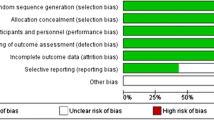Abstract
The objectives of this study were to determine whether recombinant human bone morphogenetic protein-2 (rhBMP-2) can be used as the sole stimulator of osteogenesis with success equal to an autologous graft in posterolateral lumbar fusion (PLF) at the same level and to describe the progress until bone union. This study included 11 patients who underwent PLF of L4-5. On the right side, only rhBMP-2, for which polylactic/glycolic acid (PLGA) was used as a carrier, was used, whereas, on the left side, autogenous bone was used. The bone union rate was 73 and 82% at 12 and 24 months after surgery, respectively, on the right BMP side, while the rate on the autogenous bone side was 91%. There was no statistically significant difference in the bone union rate. rhBMP-2 can be used as the sole source of osteogenesis with success equivalent to an autologous graft of the PLF.
Résumé
L’objectif de cette étude est de déterminer si la BMP humaine recombinante rhBMP-2 peut être utilisée comme le seul stimulateur de l’ostéogénèse avec un résultat équivalent à une autogreffe lors des fusions postéro-latérales lombaires. Méthode : 11 patients ayant bénéficié d’une greffe postéro-latérale de L4 – L5 ont été inclus dans cette étude. Du côté droit a été mis en place uniquement de la BMP recombinante avec comme support le PLGA et du côté gauche une auto-greffe osseuse. Résultat : le taux de fusion a été respectivement de 73% et de 82% à 12 et 24 mois du côté BMP alors que du côté de la greffe, le taux de fusion est de 91%. Il n’y a pas de différence significative entre ces deux méthodes. En conclusion : la BMP recombinante rhBMP-2 peut être utilisée comme seule source d’ostéogénèse avec un succès à peu près équivalent à celui de l’autogreffe.




Similar content being viewed by others
References
Arrington ED, Smith WJ, Chambers HG et al (1996) Complications of iliac crest bone graft harvesting. Clin Orthop 329:300–309
Banwart JC, Asher MA, Hassanein RS (1995) Iliac crest bone graft harvest donor site morbidity. A statistical evaluation. Spine 20:1055–1060
Boden SD (2000) Biology of lumbar spine fusion and use of bone graft substitutes: present, future, and next generation. Tissue Eng 6:383–399
Boden SD, Zdeblick TA, Sandhu HS, Heim SC (2000) The use of rhBMP-2 in interbody fusion cages. Definitive evidence of osteoinduction in humans: a preliminary report. Spine 25:376–381
Boden SD, Kang J, Sandhu HS, Heller JG (2002) Use of recombinant bone morphogenetic protein-2 to achieve posterolateral lumbar spine fusion in humans: a prospective randomized clinical pilot trial: 2002 Volvo Award in clinical studies. Spine 27:2662–2673
Fischgrund JS, Mackay M, Herkowitz HN et al (1997) 1997 Volvo Award winner in clinical studies. Degenerative lumbar spondylolisthesis with spinal stenosis: a prospective, randomized study comparing decompressive laminectomy and arthrodesis with and without spinal instrumentation. Spine 22:2807–2812
Fischgrund JS, James SB, Chabot MS et al (1997) Augmentation of autograft using rhBMP-2 and different carrier media in the canine spine fusion model. J Spinal Disord 10:467–472
Glassman SD, Dimar JR, Carreon LY et al (2005) Initial fusion rates with recombinant human bone morphogenetic protein-2/compression resistant matrix and a hydroxyapatite and tricalcium phosphate/collagen carrier in posterolateral spinal fusion. Spine 30:1694–1698
Grauer JN, Patel TC, Erulkar JS et al (2000) Evaluation of OP-1 as a graft substitute for the intertransverse process lumbar fusion. Spine 6:127–133
Hadjipavlou AG, Simmons JW, Tzermiadianos MN et al (2001) Plaster of Paris as bone substitute in spinal surgery. Eur Spine J 10(Suppl 2):S189–S196
Herkowitz HN, Kurz LT (1991) Degenerative lumbar spondylolisthesis with spinal stenosis. A prospective study comparing decompression with decompression and intertransverse process arthrodesis. J Bone Joint Surg Am 73:802–808
Holliger EH, Trawick RH, Boden SD et al (1996) Morphology of the lumbar intertransverse process fusion mass in the rabbit model: a comparison between two bone graft materials—rhBMP-2 and autograft. J Spinal Disord 9:125–128
Li H, Zou X, Xue Q et al (2004) Anterior lumbar interbody fusion with carbon fiber cage loaded with bioceramics and platelet-rich plasma. An experimental study on pigs. Eur Spine J 13:354–358
Magin MN, Delling G (2001) Improved lumbar vertebral interbody fusion using rhOP-1: a comparison of autogenous bone graft, bovine hydroxylapatite (Bio-Oss), and BMP-7 (rhOP-1) in sheep. Spine 26:469–478
Martin GJ Jr, Boden SD, Marone MA, Moskovitz PA (1999) Posterolateral intertransverse process spinal arthrodesis with rhBMP-2 in a nonhuman primate: important lessons learned regarding dose, carrier, and safety. J Spinal Disord 12:179–186
McKay WF, Peckham SM, Badura JM (2007) A comprehensive clinical review of recombinant human bone morphogenetic protein-2 (INFUSE Bone Graft). Int Orthop 31:729–734
Sandhu HS, Kanim LE, Kabo JM et al (1996) Effective doses of recombinant human bone morphogenetic protein-2 in experimental spinal fusion. Spine 21:2115–2122
Sandhu HS, Kanim LM, Toth JM et al (1997) Experimental spinal fusion with recombinant human bone morphogenetic protein-2, without decortication of osseous elements. Spine 22:1171–1180
Schimandle JH, Boden SD, Hutton WC (1995) Experimental spinal fusion with recombinant human bone morphogenetic protein-2. Spine 20:1326–1337
Steinmam JC, Herkowitz HN (1992) Pseudarthrosis of the spine. Clin Orthop 284:80–90
Thalgott JS, Giuffre JM, Fritts K et al (2001) Instrumented posterolateral lumbar fusion using coralline hydroxyapatite with or without demineralized bone matrix, as an adjunct to autologous bone. Spine J 1:131–137
Urist MR (1965) Bone: formation by autoinduction. Science 150:893–899
Vaccaro AR, Patel T, Fischgrund J et al (2003) A pilot safety and efficacy study of OP-1 putty (rhBMP-7) as an adjunct to iliac crest autograft in posterolateral lumbar fusions. Eur Spine J 12:495–500
Wozeney JM, Rosen V, Celeste AJ et al (1988) Novel regulators of bone formation: molecular clones and activities. Science 242:1528–1534
Author information
Authors and Affiliations
Corresponding author
Rights and permissions
About this article
Cite this article
Katayama, Y., Matsuyama, Y., Yoshihara, H. et al. Clinical and radiographic outcomes of posterolateral lumbar spine fusion in humans using recombinant human bone morphogenetic protein-2: an average five-year follow-up study. International Orthopaedics (SICOT) 33, 1061–1067 (2009). https://doi.org/10.1007/s00264-008-0600-5
Received:
Revised:
Accepted:
Published:
Issue Date:
DOI: https://doi.org/10.1007/s00264-008-0600-5




